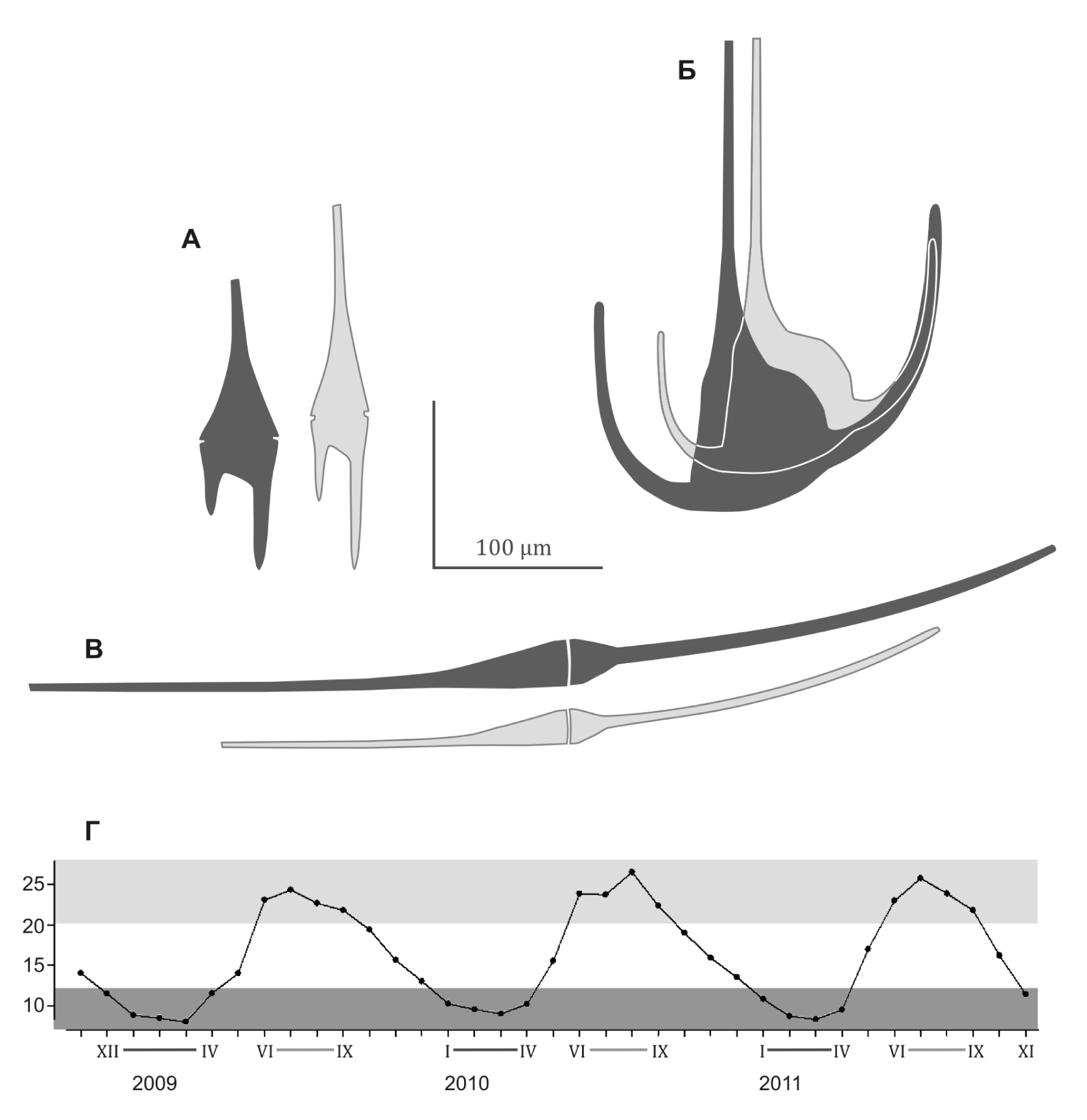Seasonal polymorphism of the Black Seas dinoflagellates from genus Ceratium: C. furca, C. fusus, C. tripos (Dinophyceae)
Abstract
The seasonal polymorphism of the three species from genus Ceratium were described in the paper. The seasonal forms were distinguished by the sizes, biovolumes and surface areas of cells theca, and values of morphometric indexes. The breadth, biovolumes and surface areas of all species were higher in cold period. The length of the horns of C. fusus and C. tripos was 1.3-1.5 times higher in winter while the length of the horns of C. furca was 1.5 times higher in summer. The winter and summer periods were distinguished by the sea surface temperature: in winter the temperate was lower 12°, and in summer it was higher 20°. It is confirmed that species of the genus Ceratiumi has “summer” and “winter” forms which are the adaptations to seasonal changes of hydrological conditions.
References
Брянцева Ю.В., Силаков М.И., Лях А.М., Георгиева Е.Ю. 2009. Использование новых методик обработки данных по фитопланктону при проведении биофизического мониторинга. Рыбное хозяйство Украины 63 (4): 26–27.
Киселев И.А. 1969. Планктон морей и континентальных водоемов. Т. 1. Вводные и общие вопросы планктологии. Наука, Ленингр. отд., Ленинград.
Лях А.М., Брянцева Ю.В. 2011. Оптимизация измерений представителей трех видов динофитовых водорослей рода Neoceratium (Dinophyceae). Морской экологический журнал 10 (2): 66–72.
Лях А.М., Брянцева Ю.В., Георгиева Е.Ю., Силаков М.И. 2011. Сезонная изменчивость значений морфохарактеристик черноморских динофлагеллят рода Ceratium Shrank (Dinoflagellata). Ботаніка та мікологія: проблеми і перспективи на 2011-2020 роки (Матеріали Всеукраїнської наукової конференції, Київ, 6–8 квітня 2011 року): 197–198. Інститут ботаніки ім. М.Г. Холодного, Київ.
Незлин Н.П. 1981. Сезонные изменения размеров и формы клеток массовых видов планктонных водорослей Черного моря. Океанический планктон и первичная продукция: 83–92. Наука, Москва.
Серикова И.М., Брянцева Ю.В., Василенко В.И. 2013. Особенности сезонной динамики структуры поля биолюминесценции и её сопряжённость с параметрами динофлагеллят. Морской экологический журнал 12 (4): 87–95.
Синеоков И. 2014. Измеряем микроводоросль в программе ИмеджДжей (ImageJ). http://3d-microalgae.org/blog/?go=all/izmeryaem-mikrovodorosl-v-programme-imagej/
Токарев Ю.Н., Мельников В.В., Жук В.Ф., Василенко В.И. 2013. Новый метод экспрессной обработки и анализа данных гидробиологических съемок в экспедиционных условиях. Морской экологический журнал 12 (2): 63–68.
Baek S.H., Shimode S., Kikuchi T. 2008. Growth of dinoflagellates, Ceratium furca and Ceratium fusus in Sagami Bay, Japan: The role of temperature, light intensity and photoperiod. Harmful Algae 7 (2): 163–173.
del Castillo M.E.M., Resendiz M.E.Z., Okolodkov Y.B., Ugarte I.H.S. 2003. Ceratium balechii sp. nov. (Dinophyceae: Gonyaulacales) from the Mexican Pacific. Hidrobiológica 13 (1): 75–91.
Dottne-Lindgren A., Ekbohm G. 1975. Ceratium hirundinella in lake Erken: horizontal distribution and form variation. Int. Rev. Gesamten Hydrobiol. 60 (1): 115–144.
Dowidar N.M. 1972. Morphological variations in Ceratium egyptiacum in different natural habitats. Mar. Biol. 16 (2): 138–149.
Gillooly J.F., Brown J.H., West G.B., Savage V.M., Charnov E.L. 2001. Effects of size and temperature on metabolic rate. Science 293: 2248–2251.
Gillooly J.F., Charnov E.L., West G.B., Savage V.M., Brown J.H. 2002. Effects of size and temperature on developmental time. Nature 417: 70–73.
Gligora M., Plenković-Moraj A., Ternjej I. 2003. Seasonal distribution and morphological changes of Ceratium hirundinella in two Mediterranean shallow lakes. Hydrobiologia 506-509 (1-3): 213–220.
Hasle G.R., Nordli E. 1951. Form variation in Ceratium fusus and tripos populations in cultures and from the sea. Mat. Naturv. Klasse 4: 1–25.
Hansen G., Larsen J. 1992. Dinoflagellater i danske farvande. In: Thomsen H.A. (ed.), Plankton i de indre danske farvande. Havforskning fra Miljøstyrelsen: 45–155. Copenhagen.
Humphries S. 2013. A physical explanation of the temperature dependence of physiological processes mediated by cilia and flagella. PNAS 110 (36): 14693–14698.
Kimmel B.L., Holt J.R. 1988. Nutrient availability and patterns of polymorphism in the freshwater dinoflagellate Сeratium hirundinella. Arch. Hydrobiol. 113 (4): 577–592
Kofoid C.A. 1909. Mutations in Ceratium. Bull. Mus. Comp. Zool. 52 (13): 213–253.
Lindström K. 1992. Ceratium in Lake Erken: vertical distribution, migration and form variation. Nordic J. Bot. 12: 541–556.
Lópes J. 1955. Variación alométrica en Ceratium tripos. Invest. Pesq. 2: 131–160.
Lópes J. 1966. Variación y regulación de la forma en el género Ceratium. Invest. Pesq. 30: 325–427.
Maxwell B.J. 2013. Split violin plots. http://mbjoseph.github.io/blog/2013/06/24/violin/
Nielsen J. 1956. Temporary variations in certain marine Ceratia. Oikos 7: 256–272.


This work is licensed under a Creative Commons Attribution-NonCommercial-NoDerivatives 4.0 International License.
The journal is licensed by Creative Commons under BY-NC-ND license. You are welcome and free to share (copy and redistribute the material in any medium or format) all the published materials. You may not use the material for commercial purposes. You must give appropriate credit to all published materials.
The journal allow the author(s) to hold the copyrights and to retain publishing rights without any restrictions. This is also indicated at the bottom of each article.





